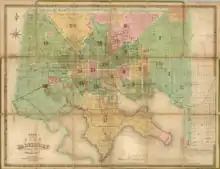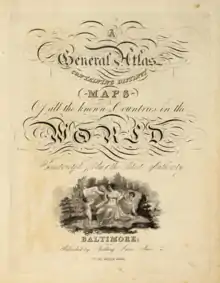Fielding Lucas Jr.
Fielding Lucas Jr. (September 3, 1781 – March 12, 1854) was a cartographer, an artist and a publisher of prominence during the early 19th century. He is known as the earliest successful commercial map-publisher in the city of Baltimore. The first of his atlases was published in 1815–17, in which the maps are closely associated with the 1822 edition of Philadelphia atlas by Carey & Lea.
| Fielding Lucas Jr. | |
|---|---|
 | |
| Born | 3 September 1781 Fredericksburg |
| Died | 12 March 1854 Baltimore |
| Occupation | Publisher |
Career history

Lucas founded Lucas Bros. Inc. in 1804 which was located at 116, East Baltimore Street, and became the first stationer in the United States. In 1806 Lucas served as the Baltimore manager of the Philadelphia publishing firm, Conrad, Lucas, and Co., when it opened its offices there.
In 1834, Lucas published the first "The Metropolitan Catholic Calendar and Laity's Directory" - an annual calendar, which was renamed to "Metropolitan Catholic Almanac" by him in 1838. In the issue of 1845 there is inserted a map of the United States, "prepared at much expense to exhibit at a glance the extent and relative situation of the different dioceses", with a table of comparative statistics from 1835 to 1845. A list of the clergy in England and Ireland was added in the volume for 1850. Because of Lucas and a younger contemporary, Ireland-born John Murphy, Baltimore was the major center of Catholic publishing until it shifted to New York City at the beginning of the twentieth century.
In 1866, his son, William F. Lucas, acquired the Lucas Bros. printing and stationery business.
Books and atlases
Below are some of the books published by Lucas:
- A New and Elegant General Atlas: Containing Maps of Each of the United States (1814)[1]
- A General Atlas Containing Distinct Maps of All the Known Countries in the World (1823)
- Lucas' Progressive Drawing Book (3 parts) (1827)[2][3]
- Part I: The Principles of drawing in Pencil
- Part II: Colouring and Shading in India Ink
- Part III: A Treatise on Perspective
- Picture of Baltimore: containing a description of all objects of interest in the city; and embellished with views of the principal public buildings (1832)
Commemorations

As an artist, Lucas helped publish one of the first color plate books titled "Flora's Dictionary", for which an 1837 review reads thus: "One of the most popular genres of color plate books in the antebellum period were those devoted to the sentiments associated with flowers. Colored illustrations of flowers were accompanied by a text which guided the reader through the hidden meanings of different blooms, with quotations and poetry appropriate to each. This is a pioneering example of this type, issued by the publishers of many early books with color, Fielding Lucas of Baltimore. Similar works were issued at every level of quality and size, from pocket-sized volumes with crude plates to highly finished folios."
David Rumsey states that, "While the same base maps were used ... the maps in [this] Lucas Atlas are far superior in quality – Welch re-engraved many of the maps for Lucas that Young & Delker has engraved for Carey & Lea."
Rumsey further notes that the "Lucas General Atlas" of 1823 was the "finest general atlas produced in the U.S. at the time", setting aside the Tanner and Finley atlases as specialized publications.
See also
References
- Lucas, Fielding Jr (1814). A New and Elegant General Atlas: Containing Maps of Each of the United States. Retrieved 10 October 2020 – via HathiTrust.
- Davis, Elliot Bostwick (April 1995). "American Drawing Books and Their Impact on Fitz Hugh Lane" (PDF). Proceedings of the American Antiquarian Society. 105 (part 1): 87–90. Retrieved 10 October 2020.
- "Lucas' Progressive Drawing Book, in Three Parts ... Consisting Chiefly of Original Views of American Scenery and Embracing the Latest and Best Improvements in the Mode of Instruction". The Metropolitan Museum of Art. Retrieved 10 October 2020.
- David Rumsey's Historical Map collection: Lucas, Fielding Jr
- "Baltimore Publishing". A History of Printing in Maryland: Selections From The Marylandia Collection. University of Maryland Special Collections. Archived from the original on 22 August 2012. Retrieved 23 August 2013.
- Maryland’s Fabulous Firsts
- BibleWiki: Directories, Catholic (Catholic Encyclopedia) - Reference to Metropolitan Catholic Almanac
- Peabody archives, City of Baltimore: Family papers
- Foster, James W. (October 1955). "Fielding Lucas, Jr., Early 19th Century Publisher of Fine Books and Maps" (PDF). Proceedings of the American Antiquarian Society. 65 (2): 160–212. Retrieved 10 October 2020.
External links
- A General Atlas Containing Distinct Maps of All the Known Countries in the World at the David Rumsey Map Collection at Stanford University Libraries
- Lucas' Progressive Drawing Book at the HathiTrust Digital Library
- Picture of Baltimore, containing a description of all objects of interest in the city at Google Books
